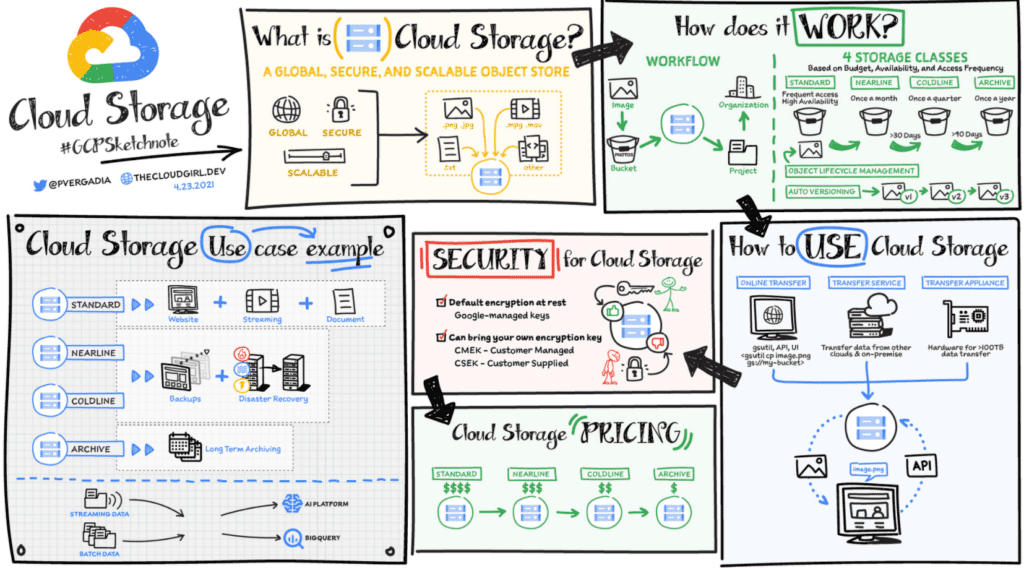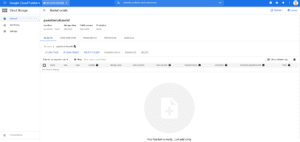As more and more businesses move to work-from-home in a time of crisis, employees need reliable and efficient ways to access company file servers and continue to collaborate on files as if they were still in the office. Google cloud storage is a reliable and scalable cloud storage service.
Cloud Storage is a global, secure, and scalable object store for immutable data such as images, text, videos, and other file formats. You can add data to it or retrieve data from it as often as your application needs. The ID, metadata, and attributes make object storage an appealing storage choice for a large variety of applications ranging from web serving to data analytics. Google Cloud Storage provides worldwide, highly durable object storage that scales to exabytes of data. You can access data instantly from any storage class, integrate storage into your applications with a single unified API, and easily optimize price and performance.

Files and Folders over the Internet Securely
For remote mobile workers, drive mapping and file locking are the two basic features for accessing files and folders over the Internet.Using gcsfuse you can map your drive to the underlying Google Cloud Storage service and its buckets, with file locking feature. You able to:
- Share folders and files via web links
- Send an email attachment as web links
- Reliable Transfer-for lengthy file transfers to survive internet glitches
- Endpoint encryption by encrypting files sitting in the local cache
- Version control, modifications to files are kept as old revisions in case they will be useful in the future
The Storage classes Analogy
We all have a bank account right, irregardless of your bank account i.e KCB or Standard Chartered ,they all have a fixed-savings account where you save a few dollars. It could be on a daily, weekly, monthly, quarterly, semi-annual or yearly plans depending on your plans. For this account there is an agreement between you and your bank where you agree to save your own defined amount of money for a set period of time before funds are available for access/withdrawal to your account, thanks to mobile banking you can do this at the comfort of your indiginenious location and no need to sign agreements at the bank.
Case scenario, what if you need to withdraw the saved funds before the set period is due? This is your money. You have all the rights to have them but remember you pledged to have them under custody by the bank until the set date which aint due, so the bank will grant you the money but at your expense aka/alias withdrawal interest. Case scenario 2: The savings account after a certain period of time your saved amount earns you interest mostly on annual basis as per you bank account
Just like the Bank account you have with your bank is the same way the Google Cloud Storage works in storing your data, Google cloud storage has four storage classes: Standard, Nearline, Coldline and Archive. The Standard class is equivalent to your normal bank account in which you can transact amounts so long as you have funds in it without any restrictions across the calendar year. The Coldline class is an equivalent of your monthly set target account(30 days) as you would access your data after 30 days. The Coldline class is equivalent to your 3 months fixed/target account, here in the course period you get to have your data stored inaccessible until 3 months are due for access but note access before period accrues an access fee per GB of data requested for access as it is in the banking there is an percentage interest off your money you pay for withdrawing the specified amount. The Archive class is equivalent to opening a fixed/target savings account with a specified period of one year(365 days).
Storage classes
There are four storage classes that are based on budget, availability, and access frequency.
- Standard buckets for high-performance, frequent access, and highest availability
- Regional or dual-regional locations for data accessed frequently or high-throughput needs
- Multi-region for serving content globally
- Nearline for data accessed less than once a month
- Coldline for data accessed roughly less than once a quarter
- Archive for data that you want to put away for years (accessed less than once a year)
It costs a bit more to use standard storage because it is designed for short-lived and/or frequently accessed data. Nearline, coldline, and archive storage offer a lower monthly storage cost for longer-lived and less frequently accessed data.
Choosing a location for your use case
Cloud Storage lets you store your data in three types of locations:
- Regional: all of your data is stored redundantly in a single region. Regional buckets usually offer the lowest monthly storage price and are suitable for a wide range of use cases, including high-performance analytics where it is important to co-locate your compute and storage in the same region.
- Multi-region: all of your data is stored redundantly across a continent but it’s not visible which specific regions your data is in. Availability is higher than regional because your data can be served from more than one region. Multi-regions cost a little more than single regions, but are great choices for content serving to the Internet.
- Dual-regions: all of your data is stored in two specific regions. Dual-regions provide the best of regions and multi-regions — providing you with high availability and protection against regional failures while also giving you the high-performance characteristics of regional storage. Business-critical workloads are often best implemented on top of dual-regions. Dual-regions can also be a great choice for a data lake for streaming as well as for batch uploading of data for big data and ML projects.
No matter the location that you select, all four storage classes are available to you so that you can optimize your costs over time, storing your most active “hot” data in Standard and moving it down to colder classes as it becomes older and less frequently accessed.
How to use Cloud Storage
With Object Lifecycle Management you can automatically transition your data to lower-cost storage classes when it reaches a certain age or when other lifecycle rules that you’ve set up apply. Cloud Storage also offers automatic object versioning, so you can restore older versions of objects—which can be especially helpful as protection against accidental deletion .
You can upload objects to the bucket and download objects from it using the console or gsutil commands, Storage Transfer Service, Transfer Appliance, or transfer online. Once you have stored the data, accessing it is easy with a single API call for all storage classes.
For a more in depth look at optimizing location and costs for your Cloud Storage buckets, check out this article: Optimizing object storage costs in Google Cloud: location and classes.
Security
By default 100% of data in Cloud Storage is automatically encrypted at rest and in transit with no configuration required by customers. You can grant permission to specific members and teams or make the objects fully public for use cases such as websites.
If you want more direct control over encryption you have two additional key management options available to you that go beyond the built-in encryption that Google manages for you:
- You can use customer-managed encryption keys (CMEK) via Google Cloud Key Management Service (KMS). You can define access controls to encryption keys, establish rotation policies, and gather additional logging into encryption/decryption activities. In both the default and customer-managed case, Google remains the root of trust for encryption/decryption activities.
- You can use customer-supplied encryption keys (CSEK) in which Google is no longer in the root of trust. Using CSEK comes with some additional risk of data loss, as Google cannot help you decrypt data if you lose your encryption keys.
Furthermore, you do not have to choose one key management option only. You can make use of the default encryption for most of your workloads, and add some extra control for select applications.
Conclusion
Whether you need to store data for regulatory compliance, disaster recovery, analytics, or simply serving it on the web, Cloud Storage has you covered.








